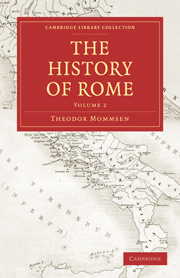Book contents
- Frontmatter
- Contents
- MAP OF ITALY
- BOOK THIRD: FROM THE UNION OF ITALY TO THE SUBJUGATION OF CARTHAGE AND OF THE GREEK STATES
- CHAPTER I CARTHAGE
- CHAPTER II THE WAR BETWEEN ROME AND CARTHAGE CONCERNING SICILY
- CHAPTER III THE EXTENSION OF ITALY TO ITS NATURAL BOUNDARIES
- CHAPTER IV HAMILCAR AND HANNIBAL
- CHAPTER V THE WAR UNDER HANNIBAL TO THE BATTLE OF CANNÆ
- CHAPTER VI THE WAR UNDER HANNIBAL FROM CANNÆ TO ZAMA
- CHAPTER VII THE WEST FROM THE PEACE OF HANNIBAL TO THE CLOSE OF THE THIRD PERIOD
- CHAPTER VIII THE EASTERN NATIONS AND THE SECOND MACEDONIAN WAR
- CHAPTER IX THE WAR WITH ANTIOCHUS OF ASIA
- CHAPTER X THE THIRD MACEDONIAN WAR
- CHAPTER XI THE GOVERNMENT AND THE GOVERNED
- CHAPTER XII THE MANAGEMENT OF LAND AND OF CAPITAL
- CHAPTER XIII FAITH AND MANNERS
- CHAPTER XIV LITERATURE AND ART
- CORRECTIONS
CHAPTER V - THE WAR UNDER HANNIBAL TO THE BATTLE OF CANNÆ
Published online by Cambridge University Press: 05 October 2010
- Frontmatter
- Contents
- MAP OF ITALY
- BOOK THIRD: FROM THE UNION OF ITALY TO THE SUBJUGATION OF CARTHAGE AND OF THE GREEK STATES
- CHAPTER I CARTHAGE
- CHAPTER II THE WAR BETWEEN ROME AND CARTHAGE CONCERNING SICILY
- CHAPTER III THE EXTENSION OF ITALY TO ITS NATURAL BOUNDARIES
- CHAPTER IV HAMILCAR AND HANNIBAL
- CHAPTER V THE WAR UNDER HANNIBAL TO THE BATTLE OF CANNÆ
- CHAPTER VI THE WAR UNDER HANNIBAL FROM CANNÆ TO ZAMA
- CHAPTER VII THE WEST FROM THE PEACE OF HANNIBAL TO THE CLOSE OF THE THIRD PERIOD
- CHAPTER VIII THE EASTERN NATIONS AND THE SECOND MACEDONIAN WAR
- CHAPTER IX THE WAR WITH ANTIOCHUS OF ASIA
- CHAPTER X THE THIRD MACEDONIAN WAR
- CHAPTER XI THE GOVERNMENT AND THE GOVERNED
- CHAPTER XII THE MANAGEMENT OF LAND AND OF CAPITAL
- CHAPTER XIII FAITH AND MANNERS
- CHAPTER XIV LITERATURE AND ART
- CORRECTIONS
Summary
Hannibal and the Italian Celts
The appearance of the Carthaginian army on the Roman and the side of the Alps changed all at once the situation of affairs, and disconcerted the Roman plan of war. Of the two principal armies of the Romans, one had landed in Spain and was already engaged with the enemy there: it was no longer possible to recall it. The second, which was destined for Africa under the command of the consul Tiberius Sempronius, was fortunately still in Sicily: in this instance Roman delay for once proved useful. Of the two Carthaginian squadrons destined for Italy and Sicily, the first was dispersed by a storm, and some of its vessels were captured by the Syracusans near Messana; the second had endeavoured in vain to surprise Lilybæum, and had thereafter been defeated in a naval engagement off that port. But the continuance of the enemy's squadrons in the Italian waters was so inconvenient, that the consul determined, before crossing to Africa, to occupy the small islands around Sicily, and to dislodge the Carthaginian fleet operating against Italy. The summer passed away in the conquest of Melita, in the chase after the enemy's squadron, which he expected to find at the Lipafi islands while it had made a descent near Vibo (Montteleone) and pillaged the Bruttian coast, and, lastly, in gaining information as to a suitable spot for landing on the coast of Africa; so that the army and fleet were still at Lilybæum, when orders arrived from the senate that they should return with all possible speed for the defence of their homes.
- Type
- Chapter
- Information
- The History of Rome , pp. 112 - 138Publisher: Cambridge University PressPrint publication year: 2010First published in: 1862



